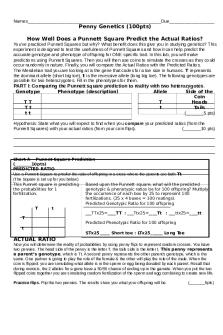Efly-993134 - biology genetics assignment PDF

| Title | Efly-993134 - biology genetics assignment |
|---|---|
| Course | Biology Of Cells And Organisms |
| Institution | University of Melbourne |
| Pages | 2 |
| File Size | 119.4 KB |
| File Type | |
| Total Downloads | 61 |
| Total Views | 138 |
Summary
biology genetics assignment ...
Description
GeneLab:eFly
Biol10005 Genetics and the Evolution of Life: Assignment
AIM: To investigate • the dominance of the mutant phenotype at each locus • whether the genes are autosomal or X linked • if the loci are assorting independently. ANSWERS ARE TO BE TYPED IN NO LESS THAN 11 POINT FONT and YOU MUST ONLY USE THE SPACES PROVIDED FOR ANSWERS METHOD: In the box below in WORDS describe the crosses you will perform. Provide a reason why you are completing this/these cross/es Do not use allelic symbols. You will lose marks for choosing crosses that are uninformative.
For aim 1, a pure-breeding wild type and black body/apterous wings (mutant phenotype) will be crossed to determine which phenotype is dominant/recessive. The phenotype of the heterozygous progeny will be selected as the dominant one. For the second aim, a reciprocal cross will be performed. A purebreeding wild type female will be crossed with a purebreeding mutant male, the phenotypic ratio of the offspring will be noted, then another cross with a homozygous mutant female and wild type male, will be performed and noted. If the result in identical offspring phenotype ratios, then the genes will be autosomal, if different, then the genes will be x-linked. Finally, to determine if the loci are assorting independently a test cross where a heterozygous individual will be crossed with a homozygous recessive mutant individual. If the offspring phenotypic ratio is 1:1:1:1, then the genes are independently assorting.
RESULTS: Using the efly program perform these crosses, export the data (as instructed in the program) and present it in a clearly labelled, formatted table. (do not include images of flies)
Cross 1 [Dihybrid cross] Parents: Black body, apterous wings ♂ x Wild type ♀ Progeny: Phenotype Observed males
Observed females
Total
Wild type 466 534 Black body, apterous wings 0 0 Cross 2 [Reciprocal cross] Parents: Wild type♂ x Black body, apterous wings ♀ Progeny: Phenotype Observed males Observed females Wild type 496 503 Black body, apterous wings 0 0 Cross 3 [Test cross] Parents: Homozygous black body, apterous wings ♂ x Heterozygous wild type ♀ Progeny: Phenotype Observed males Observed females Wild type 234 230 Black body, apterous 238 231 wings Black body 17 14 Apterous wings 13 23 Map distance = recombinant / total *100 [(31+36)/1000]*100 = 6.4 cM
1000 0
Page 1
Total 1000 0
Total 464 469 31 36
DISCUSSION and CROSSES - Reminder do not exceed the spaces provided Propose a genetic model/hypothesis
For these genetic crosses there are two loci involved and 4 alleles; two for each gene. The map distance between the gene loci is approximately 6.4 map units. It is hypothesised that the dominant phenotype is the wildtype for both loci while the mutant phenotypes; black body and apterous wings are recessive as shown by the phenotypically wildtype heterozygous progeny from cross 1. Both loci are autosomal, indicated by the reciprocal crosses (cross 1 &2) that show identical phenotypic ratios in the offspring. Lastly, the loci are not independently assorting, given the ratios of the parents and recombinants do not follow the phenotypic ratio of 1:1:1:1(cross 3). Chi Square testing
Null hypothesis: There is no difference between the observed and expected values, other than that due to random chance. Cross 3
Wild type
Black body, apterous wing 469 250 191.844
Observed (O) 464 Expected (E) 250 (O-E)2/E 183.184 X2= 2(183.184) + 2(191.844) = 750.056 = 750.06 Degrees of freedom: 4-1=3 P...
Similar Free PDFs

Cell biology and genetics
- 12 Pages

Laboratory Assignment 5 Genetics
- 12 Pages

Biology Lab Assignment #1
- 1 Pages

Topic 3 Biology Assignment
- 3 Pages

biology lab assignment
- 2 Pages

Genetics Penny Genetics
- 4 Pages
Popular Institutions
- Tinajero National High School - Annex
- Politeknik Caltex Riau
- Yokohama City University
- SGT University
- University of Al-Qadisiyah
- Divine Word College of Vigan
- Techniek College Rotterdam
- Universidade de Santiago
- Universiti Teknologi MARA Cawangan Johor Kampus Pasir Gudang
- Poltekkes Kemenkes Yogyakarta
- Baguio City National High School
- Colegio san marcos
- preparatoria uno
- Centro de Bachillerato Tecnológico Industrial y de Servicios No. 107
- Dalian Maritime University
- Quang Trung Secondary School
- Colegio Tecnológico en Informática
- Corporación Regional de Educación Superior
- Grupo CEDVA
- Dar Al Uloom University
- Centro de Estudios Preuniversitarios de la Universidad Nacional de Ingeniería
- 上智大学
- Aakash International School, Nuna Majara
- San Felipe Neri Catholic School
- Kang Chiao International School - New Taipei City
- Misamis Occidental National High School
- Institución Educativa Escuela Normal Juan Ladrilleros
- Kolehiyo ng Pantukan
- Batanes State College
- Instituto Continental
- Sekolah Menengah Kejuruan Kesehatan Kaltara (Tarakan)
- Colegio de La Inmaculada Concepcion - Cebu









